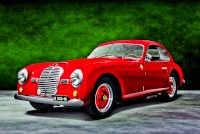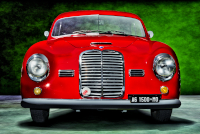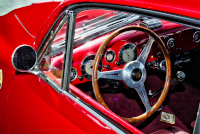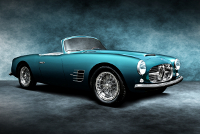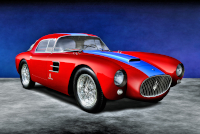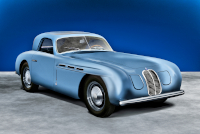Location:
Broad Arrow Auctions, Amelia Island, 2025
Owner: Thomas Smith & Donald Polak | Nashville, Tennessee
Prologue:
A close cousin of the Cisitalia 202, both products of Pinin Farina, the Maserati A6 1500 is a slightly cleaner design, though ostensibly different than the A6 prototype delivered to the 1947 Geneva Motor Show. The similarity demonstrates a rational approach to developing a modern touring car without excessive cost.
Simple origins, from which point the A6 becomes a diverse family of sports-racing and sports-touring cars.
The berlinetta depicted here is among the last of the original A6 1500 series, a good point to examine Pinin Farina's design concept applied to the Cisitalia and Maserati platforms.
- - - - - - - - - -
► Image Source: Nikon D750 (24.3 MP)
References:
- Cancellieri, Gianni; Dal Monte, Luca; De Agostini, Cesare; Ramaciotti, Lorenzo. (English translation by Neil Davenport and Robert Newman.) "Maserati, A Century of History: The Official Book" Giorgio Nada Editore, Vimodrone, Milano, Italia. 2013, page 104-111
- Crump, Richard; de la Rive Box, Rob. "Maserati Sports, Racing and GT Cars from 1926" Third Edition, G.T. Foulis & Company for Haynes Publishing Group PLC, Somerset, England. 1992, page 80, 104-108
- Broad Arrow Auctions: The auction entry for #0101, which includes a documentation file.
- Radical Magazine: An overview of the Maserati A6 1500 with a compilation of chronologically ordered examples.
- UltimateCarPage: A brief look at the A6 1500 via the early (and unique) Zagato-bodied Panoramica coupe, chassis #052, by Wouter Melissen, January 25, 2010.
The early post-War sports car in Italy develops along Cisitalia, Maserati, and Lancia designs, each one a prototype exercise followed by limited production. These are clean, elegant examples of modern form that draw the automobile's disparate components into a uniform body.
The production version of the Maserati A6 follows the Cisitalia design, not without surprise given the mechanical similarity of the platforms given to Pinin Farina. But the 1947 Maserati A6 prototype that precedes the production berlinetta is a more exceptional form. I will dedicate some energy to that car separately and note that many sources discuss the prototype at length in the context of the production car, which diverts attention from the material fact of what this car is.
One could argue that the transition from show prototype to production car is more important than the former's extraordinary design. Through the classic era, Maserati were a racing stable. But the brothers clearly harbored ideas of road car manufacture, known by design sketches and a few lost road cars of unique configuration. So in the post-War era they begin afresh by developing a road car in 1946, the origins of which date back to as early as 1940. The memorialized designation, 'A' for Alfieri, suggests a rekindling of the company in the spirit of its original foundation.
As quickly as it began... Though it is the result of a concept percolating for decades, the A6 1500 is the final project developed under the leadership of the three remaining Maserati brothers, Ernesto, Ettore, and Bindo. Contributors Alberto Massimino and Vittorio Bellentani will continue with Maserati under Orsi control, responsible for perpetuating the spirit of Maserati racing in proper form without the brothers themselves, who leave in 1947 to form O.S.C.A.
The similarity between A6 1500 development and the concurrent O.S.C.A. concept very well demonstrates the type of car the Maserati brothers are most interested in building. This is the divergence point. Both the A6 and the O.S.C.A. are wholly modern cars. They emphasize tractability through lightweight components and minimalist engineering expression.
In this sense, the Maserati brothers demonstrate their keen sense of industry-leading direction. Whereas many look at these cars in concert with the Cisitalia 202 as bellwethers for the Italian GT concept, the A6 and its O.S.C.A. cousins are rather early developments of the Lotus concept. Ten years later, in 1957, Colin Chapman will repeat this process, translating his racing car ethic to the Lotus Elite.
A6 1500 Chassis #0101 History
Pinin Farina receive chassis #0101 in March of 1950 and complete the coachwork for delivery to Guglielmo Dei of Rome in December of 1950, (Dei of the Pinin Farina A6GCS/53 berlinetta cars later to appear in 1954). Maserati's Rome agent holds the car until July of 1951 before finding an owner, Sr. Catullo del Monte.
About a year later, del Monte passes the car to Edwin Henry Morris, and American in Rome, who imports the car to the United States. Chassis #0101 remains an expatriated automobile for the remainder of the 20th century.
In this time, #0101 receives a restoration from the shop of Claudio Zampolli, the Los Angeles-based designer who contributed to the Miura's development. Along with a small team of Lamborghini engineers, Zampolli also led the development of the fascinating Cizeta V16T in the late 1980s. In this case, his connection to this Maserati A6 1500 is an interesting point of automotive reference.
Back to its history, chassis #0101 briefly relocates to Japan in the early 21st century before returning once more to the United States. A concours entrant and Mille Miglia participant, #0101 proves the A6 to be a rather successful export product, if underestimated for its broader effect on the modern sports car industry.
Motor: 1,488 cc straight 6-cylinder, alloy block and head | 66 mm x 72.5 mm | 7.5:1 compression | #0101
Ernesto Maserati and Alberto Massimo develop the 1.5-litre unit early in the post-War era. This motor appears to be a derivation of the 1,493 cc from the 6CM that dates to the classic era. Crump and de la Rive Box write that, "This model earned the factory a tremendous reputation during 1936 and 1937, at a time when it was much needed." So the 1.5 litre motor is perhaps both a rational and economical starting point for post-War development.
Valvetrain: SOHC, 2 valves per cylinder
Aspiration: triple Weber 36 DCO4 carburetors
Motor #0101 received a very late modification to a period-correct triple carburetor intake set-up. The car's original configuration was the more modest single Weber 36 DCR carburetor, which would operate with 7.25:1 compression.
Power: 90 bhp at 5,000 rpm
The original figure for the single-carburetor set-up is 65 bhp at 4,700 rpm.
Drivetrain: 4-speed gearbox, rear-wheel drive
Note that #0101 appears to use a 5-speed gearbox.
Front Suspension: independent double wishbones with coil springs, Houdaille dampers
Rear Suspension: live axle with semi-elliptic leaf springs, Houdaille dampers
Architecture: steel tubular frame with longitudinal and cross members, aluminum body by Pinin Farina of Torino
Kerb Weight: 800 kg (1,763.7 lbs)
Wheelbase: 2,550 mm (100.39 inches)
Top Speed: 155 km/h (96.3 mph)
Etymology:
The all-important 'A' memorializes Alfieri, founder and spiritual leader among those four mechanically inclined brothers (of seven) who venture into racing car development. '1500' denotes the motor capacity, derived from the firm's success in voiturette racing during the classic era.
Maserati's own terminology appears to be 'Turismo Coupé,' whereas the car would otherwise be described as a berlinetta. But as Maserati opt for the French term, I follow suit.
Figures:
The official history cites 61 A6 cars produced from 1947 to 1950. Of those, perhaps 56 comprise the production run, whereas the remainder are prototypes of some variety.
Birth of the Berlinetta: A6 1500 and Cisitalia 202 Comparison
If the prophetic Paul Jaray school of aerodynamic thinking propels the modern automobile toward a trim, fully enveloped shape, then the Cisitalia 202 and the Maserati A6 1500 are the primary products. Pinin Farina scale the shape to a production-ready form, and from 1946 to 1948 demonstrate a number of variants across Cisitalia, Maserati, and Lancia chassis.
We know of the integrated body concept from the pre-War era, so none of these cars is the first in this regard. However, it is worth noting that the marques who lead the conceptual development are the smallest of independent sports car manufacturers, the tiny Cisitalia group and brothers Maserati. (Lancia, it can be said, would seem like an industrialist enterprise in comparison, though they are among the most innovative in automotive history, and for their cleverness and eccentricity never achieve the sprawl of their Italian rivals.)
With this context established, the production A6 and 202 look very similar. Pinin Farina's 1947 A6 prototype suggests a different direction for the trident marque, but by the time of production the shape becomes a close copy of the Cisitalia. To hypothesize for a moment, the reasons probably hinge on i) favorable enough public response to the Cisitalia design, ii) simplification of A6 production coachwork at Pinin Farina, and iii) cost-avoidance in terms of producing a less conventional bespoke car whose design is more complicated.
The A6 1500 prototype from the 1947 Geneva Motor Show, chassis #051, proves just as remarkable. However, retractable headlamp pockets, embellishment on the flanks, and a more deeply contoured roof with wrap-around rear window would no doubt push production costs beyond that of Cisitalia. In contrast, the public could purchase (albeit in limited number) the same 202 design seen at the 1947 Paris Salon. In this regard, a close copy makes sense. So the A6 sacrifices a chance at forging a singular identity (at least for the time being) in favor of marketability.
In comparison, the A6 wheelbase is 150 mm longer than the 202. This difference translates to a slightly elongated perspective, whereas the 202 appears ever so slightly more evenly proportioned. But the difference is scant, and variations from one car to the next often distort a sense of what the canonical representation of the 202 should be.
In this regard, the A6 1500 accentuates its long bonnet. The flanks are simplified, of which Angelo Tito Anselmi writes, "Fundamental experience of plain style. More significant than the Cisitalia 202 for the future of the Italian GT." To my mind, this verdict seems rudimentary, because a simple design is easier to identify as the ancestor of those that follow. The berlinetta concept progresses rather quickly in Italy, pitched forward by Pinin Farina, whereas the likes of these particular cars won't be seen again until Colin Chapman's Lotus Elite.
Another oddity in this comparison, the lengthy proportions and clean flanks of the A6 1500 make the car rather striking in profile, whereas the 202 fairs less well when its curves become flat in profile. Conversely, the 202 is a beautiful creation when viewed in quarter perspective, its curves drawn into cohesion, whereas the A6 1500 appears slightly distorted in quarter perspective. I do run the risk of fabricating an observation that does not hold true in every instance, but at least raising the point underscores that our physical relation to an object matters greatly when considering its design.
Last Updated: May 4, 2025

